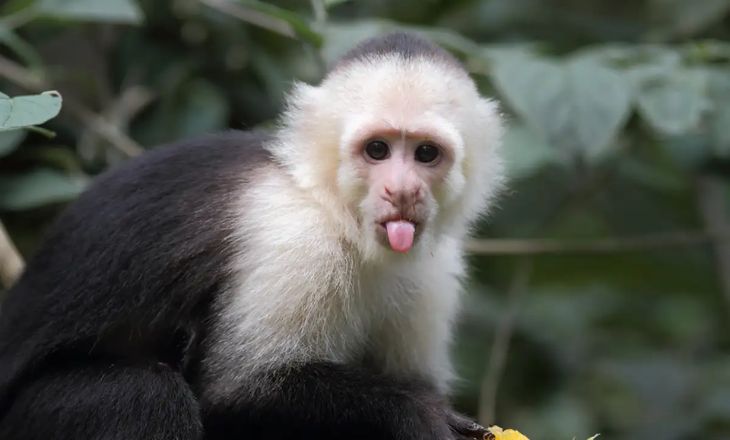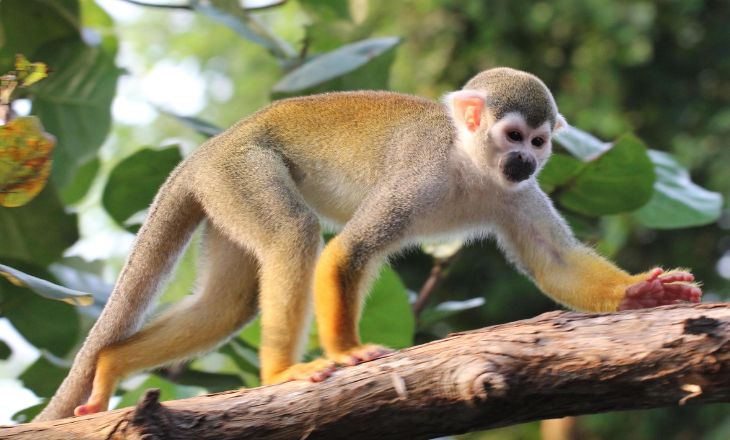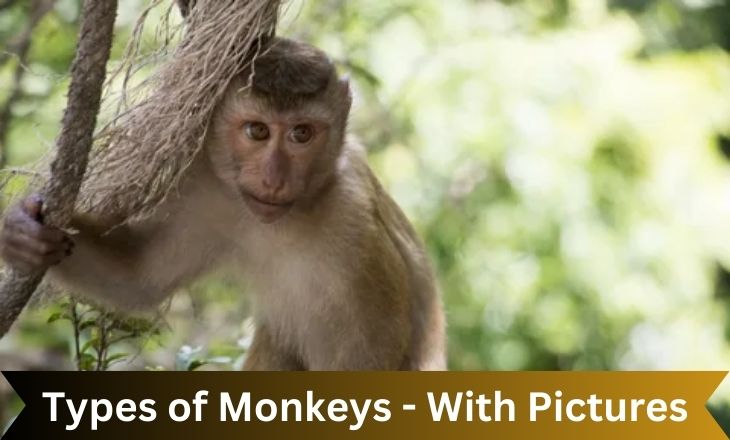Welcome to the exciting world of monkeys, where they swing their tails and make playful sounds in the trees. This article will explore different types of monkeys with pictures and descriptions.
Each species shows a unique part of nature, from Spider Monkeys swinging in the rainforest to Capuchins being mischievous. We will look at various monkeys from different continents, learning about their behaviors and habitats.
So, prepare to learn and appreciate these smart and charming creatures living with us on Earth. Grab a banana, a popular monkey treat, and let’s explore the world of these amazing primates!
Types Of Monkeys Pets
Monkeys are cute and smart animals that some people like to keep as pets. There are different types of pet monkeys, each with its special qualities.
Capuchin monkeys are popular pets because they are playful and can learn tricks easily.
Spider monkeys are good climbers with long limbs and tails, making them great companions for active people.
Squirrel monkeys are small but have big personalities, enjoying social interactions with humans. However, owning a pet monkey requires knowing much about their care and behavior.
Monkeys need attention, mental stimulation, and a special diet to be happy in captivity. Keeping exotic pets like monkeys is a big responsibility with challenges that potential owners should consider carefully before getting one.
Capuchin Monkey
Capuchin monkeys are smart and social animals, often chosen as pets. They are playful and can solve problems, even using tools in the wild. While they can bond with humans, they need a lot of care. Capuchin monkeys can learn tasks like sorting objects by color or shape.
They are curious and agile, needing a stimulating environment to avoid boredom. Potential owners should research and understand the commitment needed to care for a Capuchin monkey.

Capuchin Monkey Lifespan
Capuchin monkeys are smart and can live long in the wild, usually 15 to 25 years. But in captivity, they can live even longer, up to 45 years or more. This difference is because they don’t have predators, get medical care, and always have enough food.
Their lifespan is also affected by their relationships and social groups. Monkeys with strong bonds live longer because they get support and protection from their friends.
Things like losing their homes to people can also make their lives shorter and less happy.
Spider Monkeys
Spider monkeys are social animals that live in big groups in the rainforests of Central and South America. They have long limbs and tails with which they can grip things. These monkeys are good at moving quickly through the trees.
They communicate using sounds, faces, and body movements. Spider monkeys eat fruits, leaves, insects, and sometimes small animals. They help spread seeds in the forest, which is important for the environment.
Even though they face dangers like trees being cut down and hunting, spider monkeys are good at surviving in different places. Watching them in the wild can teach us much about how primates behave and interact.

Squirrel Monkeys
Squirrel monkeys are popular pets due to their small size and friendly nature. They are curious and like to socialize.
Owning a squirrel monkey requires special care. They communicate using sounds and body language within their groups. They are agile and good at acrobatics. Despite their cute looks, they have complex social structures.
It is important to think about the ethics of keeping them as pets. They need specific food and living conditions that match their natural habitats.
By caring for squirrel monkeys properly, we can appreciate them more and help protect them in the wild.

Monkey Baby
Monkeys are playful and protective towards their babies. A baby monkey clings to its mother’s fur, showing vulnerability and dependence. Watching a baby monkey explore with curiosity is heartwarming. The bond between a mother monkey and her baby is strong.
The mother provides care and attention to ensure the baby’s well-being. Baby monkeys learn skills like climbing and finding food with their mothers’ help. They become more independent as they grow but rely on their mothers for protection and guidance in the wild.
Monkeys Habitat
Monkeys live in many different places, like rainforests and savannas. They can adapt well to different environments, showing their ability to survive and evolve. Monkeys often live together in big groups called troops.
In these groups, they have social structures and communicate in advanced ways. Living in groups helps monkeys stay safe from predators and work together to find food.
Smallest Monkeys In The World
The smallest monkeys are pygmy marmosets. They are tiny primates from South America. They are known for their small size and agility. They weigh about 4-5 ounces and are 5-6 inches long. Pygmy marmosets show strong social bonds within their families.
Smartest Monkey Breed
Bonobos are considered the smartest monkeys due to their advanced social skills and problem-solving abilities. They communicate through sounds and gestures, understand and respond to other’s emotions, and are skilled at using tools like sticks to obtain food efficiently.
What Is The Cutest Monkey?
The pygmy marmoset, or the finger monkey, is a small and adorable primate from South America’s rainforests. It is one of the smallest monkeys in the world, with big eyes, soft fur, and a playful nature that makes it lovable.
Another cute monkey is the golden lion tamarin, with striking orange fur and long manes like a lion’s. These primates are visually stunning, social, and intelligent. They live in Brazil’s Atlantic Forest and are adored by animal lovers worldwide for their charming personalities.
Average Iq Of Monkey
Monkeys are intelligent animals, but their smarts vary by species. Capuchin monkeys, for example, are as clever as three-year-old kids. They excel at problem-solving. Each monkey species has cognitive abilities and social structures that impact their intelligence. Vervet monkeys, for instance, are smart because they communicate well through sounds and gestures.
Can Monkeys Swim
Monkeys are not good swimmers because they are not built for swimming. Some monkeys, like proboscis monkeys in Borneo, have been seen swimming in the wild. Their webbed hands and feet help them swim well, showing how they have evolved to their environment.
Monkeys near water may swim to escape predators or move around better, demonstrating their intelligence and adaptability.
Do Monkeys Eat Fish
Monkeys usually don’t eat fish like chimpanzees or baboons. They mostly eat fruits, leaves, nuts, insects, and sometimes small animals or birds. Some monkeys near the water might catch and eat fish, but not all do this.
Do Monkeys Eat Bananas?
Monkeys have different food preferences. Some like bananas, but others prefer different fruits or foods. This depends on where they live and what they usually eat. Monkeys are smart and can adapt to different food sources. Bananas are just one of the many foods they eat. Studying monkey diets can help us learn more about their behavior and how they survive in different places.
Monkey Species Names
There are over 260 types of monkeys worldwide, each with its own name and special traits. Monkey names are interesting, like the Colobus monkey, named after the Greek word for mutilated because it has no thumbs.
The Golden Snub-nosed monkeys have upturned nostrils and golden fur. The Proboscis monkey has a long nose like a trumpet, helping them in group interactions.
Spider monkeys have long limbs and tails resembling spider legs as they move through trees. Each monkey’s name describes their appearance, behavior, and habitat, showing the diversity and wonder of these creatures in nature.
Scientific Name Of Monkey
Monkeys are smart and playful animals that are part of the Cercopithecidae family. There are many types of monkeys with different traits and behaviors. The Macaca genus is famous for monkeys like the rhesus and Japanese macaques.
What Is A Big Monkey Called
A big monkey is called an ape. Apes include chimpanzees, gorillas, orangutans, and bonobos. These creatures are smart, social, and strong. Apes are bigger than most monkeys and stand upright without tails. They are smart and can solve problems. Studying apes can help us learn about our evolution and animal intelligence.
Conclusion
There are a wide variety of monkey species with unique characteristics and behaviors. From the playful capuchin to the agile spider monkey, types of monkeys offer charm and intrigue.
By exploring these different species through pictures and descriptions, we can gain a deeper appreciation for the diversity of primates in the animal kingdom. Whether you are fascinated by their intelligence, social structures, or physical abilities, there is no shortage of reasons to study and admire these remarkable creatures.
So next time you see a monkey in the wild or at a zoo, take a moment to observe and learn about its species – you may just find yourself more captivated by these amazing animals than ever before.
Care for cut peonies like a pro with our Monkey Baby guide. Enhance the lifespan and beauty of your flowers effortlessly. Click here!
Frequently Asked Question
What Are The 7 Classifications Of A Monkey?
New World monkeys, Old World monkeys, prosimians, apes, colobus monkeys, langurs, and marmosets.
What Is The 7 Monkey Theory?
The 7-monkey theory suggests that if seven monkeys were to type randomly on typewriters for an infinite amount of time, they would eventually produce the complete works of Shakespeare.

